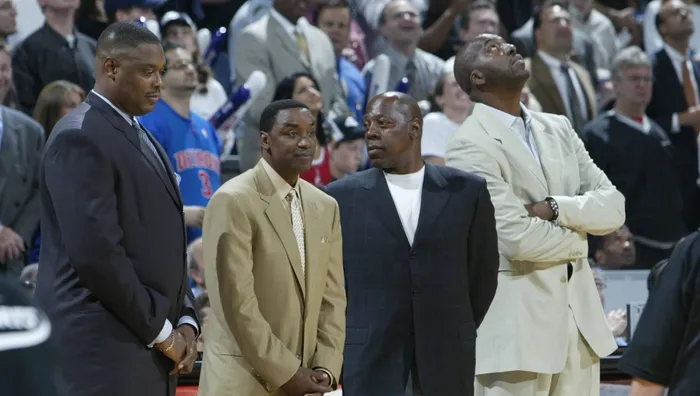
In a league of legends, the truth doesn’t always get the last word.
But every so often, someone who was actually there steps up, clears the smoke, and rewrites the script.
That someone? John Salley.
On Scoop B Originals Presents: The Freezeout, the four-time NBA champion and original Detroit Bad Boy didn’t mince words when addressing the long-standing tale that Isiah Thomas was the mastermind behind “freezing out” Michael Jordan during the 1985 NBA All-Star Game.
“It was a false narrative,” Salley said bluntly.
“Isiah took the fall when they said he didn’t want to give the ball to Michael, which when you watch that game, he gave the ball to Michael the whole time.”
Let’s pause right there.
The ‘Freezeout’ story — where veterans on the Eastern Conference squad supposedly refused to pass to the rookie sensation out of North Carolina — has followed Isiah like a shadow for decades. It’s been referenced in books, documentaries, podcast episodes, and barbershop debates from Detroit to Decatur.
But for someone like Salley, who spent six seasons with Thomas in Detroit and won two championships by his side, the narrative just doesn’t hold weight.
“When you watch that game,” Salley emphasized again,
“He gave the ball to Michael the whole time.”
THE BAD BOYS AND THE BOOGEYMAN

The Detroit Pistons of the late ‘80s and early ‘90s were built on defense, discipline, and dog mentality. Led by Thomas, Salley, Dennis Rodman, Joe Dumars, and Bill Laimbeer, they were everything that traditional NBA elegance wasn’t.
But while the team embraced their “Bad Boys” image, Salley says the media often confused grit for grudge.
“Michael and I had the same agent and at times, he wanted me not to like Isiah,” Salley revealed.
“It was his personal thing, but there’s no reason for that to be like that.”
That part? That’s huge.
It adds another layer to the Jordan-Isiah drama — one not often talked about in public: third-party influence. This wasn’t just about players competing for greatness. It was also about the people around them — agents, execs, publicists — shaping allegiances, perceptions, and ultimately, legacies.
But even with all of that, Salley’s opinion of Isiah hasn’t changed.
“He is a really good guy,” Salley said.
“One of my favorite people.”
That’s love.
And it’s the kind of love that often gets lost in the bright lights and heavy edits of sports media.
THE NARRATIVE THAT NEVER DIED

Here’s what we know:
The 1985 NBA All-Star Game took place at the cavernous Hoosier Dome in Indianapolis. It was Michael Jordan’s first All-Star appearance. He wore gold chains, he was backed by a Nike deal, and he had already started climbing into the stratosphere of superstardom.
Some of the league’s elder statesmen reportedly weren’t too fond of the flash.
The whispers said: Isiah didn’t like it. Magic Johnson didn’t like it. George Gervin didn’t like it.
The whispers said: they iced him out of the offense.
And then… those whispers became canon.
In The Last Dance, Jordan addressed it again. The camera panned. The music swelled. And the myth lived on.
But for someone like John Salley, who watched Isiah lead, watched him win, and watched him get villainized?
The story needs fixing.
“It was a false narrative.”
Simple as that.
MORE THAN A GAME

Sports are full of rivalries. Some of them are genuine. Some of them are manufactured. And some — like Jordan and Isiah — live in that complicated in-between space.
But when someone who was inside the locker room, who broke bread with both sides, and who saw the dynamics firsthand says, “It wasn’t like that”? You listen.
Because Salley didn’t just see Isiah as a teammate. He saw him as a man, as a mentor, and as a misunderstood figure in NBA history.
“He is a really good guy,” Salley said again, almost as if to double down.
“One of my favorite people.”
This isn’t damage control. It’s legacy repair.
And in the era of receipts, rewatches, and reframing — the truth matters.
FINAL THOUGHT: THE MYTH MEETS THE MOMENT

The longer you cover basketball, the more you realize that history isn’t just about who won the game — it’s about who gets to tell the story.
For years, Isiah Thomas has worn the weight of a narrative that John Salley, one of his closest allies in the league, says flat-out isn’t true.
“He gave the ball to Michael the whole time.”
So maybe it’s time we start listening to the players who lived it — not just the documentaries we stream.
Because the Freezeout? According to Salley?
It never really happened.


